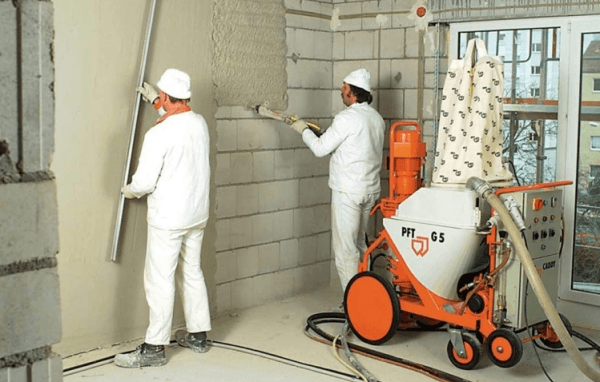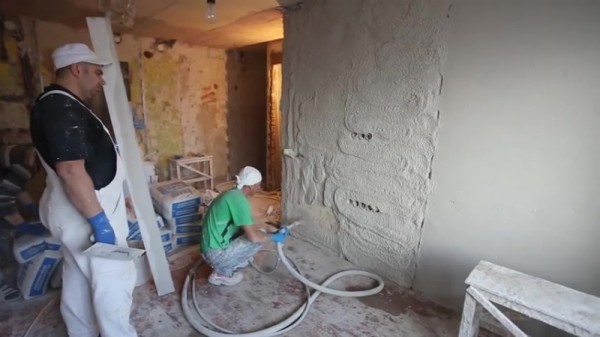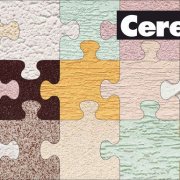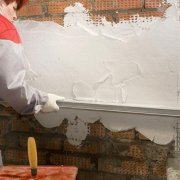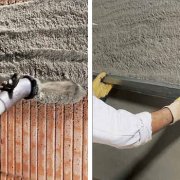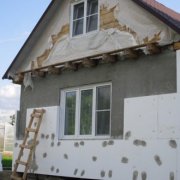Machine plaster: how to do it right
Plastering machine is quite useful for large areas of work. If everything is done manually, then the price of the work will be large. Now it’s quite possible to rent a device and do all the work yourself. Today we will tell you how plastering is done by machine video. It will help you understand the details of the work.
The content of the article
Units and options for applying plaster
The plastering machine is perfectly transported by a small car; Gazelle is quite suitable. The machine for plaster is powered by a 220V network. The maintenance staff consists of one or two specialists. But on a large area it is more convenient to carry out the work as follows: two are engaged in the application of plaster, four are involved in its leveling.
- At the same time, manufacturers paid attention to ensure that the mixture passed freely along the mortar sleeve and did not spread out over the working surface. The mixture is firmly attached to the working area, provides a high degree of adhesion, which in turn increases the quality of work.
- Due to the fact that with your own hands it is practically impossible to achieve the same force of pressing the tool on the mortar, in certain areas, the plaster may not fit snugly against the working wall. At the same time, application by mechanical means provides the same pressure over the entire area, which guarantees a uniform quality of work for the entire surface.
The scope of use of the unit is determined by the characteristics of the components that are present in the working solution.
If the cement mixture has no restrictions on use, then gypsum is not used everywhere. In places of high dampness, it collapses and falls. Therefore, mortars based on gypsum and cement should be used in buildings with an arid microclimate, in which there is practically no difference in humidity.
What is the principle of operation of the plaster
Plastering machines are quite easy to use, all the work is as follows:
- The device is connected to a power source. In buildings with water supply, water is supplied using an elastic hose. If there is no water supply, the use of imported water is allowed. It does not matter.
- Dry building mortar (see Dry plaster gypsum mixture: features of use), which is used for plastering, fall asleep inside. The required volume of liquid is pumped through the pump, after which the mixing of the solution begins.
- The resulting mixture, flowing through an elastic sleeve, under the influence of pressure falls on the working area.
Attention: In turn, it is the person’s responsibility to monitor the number of components and evenly distribute the mixture along the working plane.
Advantages and disadvantages of hardware plastering
Each technique and substance has its positive and negative sides. A technology that satisfies everyone 100% has not yet been invented. Most likely, this is why there are so many different methods, assemblies, and manufacturers.
This type of application of plaster also has its advantages and disadvantages:
| Advantages | Let's see in which cases plastering machines will be useful:
|
| disadvantages |
|
As a result, manufacturers greatly facilitated the work of builders, making the process mechanized. Now the work can be carried out in a shorter time and, ultimately, the client will be satisfied with the deadlines and quality.
Instructions for applying plaster mechanically
A stucco machine video will help you see the whole progress of work. Of course, you will need to thoroughly understand everything. After all, a grinder on the plaster of a mechanic and in its work must be considered.
Cooking area
The grinder to the plaster should be conveniently located and before starting work, it is necessary to clear the working area from the formwork, concrete flows and joints, the adhesive layer, the masonry mixture, if they protrude 10 mm or more. In addition, all elements of metal structures need to be cut and protected against corrosion.
All surface areas that are not fixed - need to be fixed or eliminated:
- Using a paint roller (cm.Paint rollers: consider in detail), are cleaned of dust, and the primer "Concrete contact" is carried out panel and solid bases made of concrete, painted parts, plasterboard and gypsum fiber;
- Planes consisting of ceramics, silicate brick or blocks, and other substances with a rough and absorbent surface undergo a primer operation with Grundermittel"Or similar fixing compounds. Apply the primer with a spray gun or mowls under high pressure. They guarantee reliable dust removal;
- Surfaces that have gaps and are located on the border with other materials are strengthened by a nylon grid with cells of 5/5 mm - 10/10 mm.
Work plane layout
An automatic plastering machine applies the material on a properly prepared plane. Moreover, you can not do the preparation for the plots.
- Applying the level, 2-3 m of length, the verticality of the plane is controlled, the horizontalness of the plane - a sample or cord. As a result, the most prominent sector is established;
- The angles of the structure are examined using an angular gauge and an angular rule;
- To set up lighthouses (seeInstallation of beacons for plaster without problems), the marking of the working areas is applied. In order to fix the beacons, “mortar tracks” are applied to the marked zones.
Plastering using a mechanized apparatus (saping)
In accordance with the operating rules, it is necessary to carry out the preparation of the machine, after which, fill in a dry solution.
- The gun with the stucco mixture must be kept at a distance of 20-30 cm from the plane, so that the mixture flows onto it strictly at right angles. With your arms straightened, open the air cock.
- Evenly apply the solution to the working area so that each subsequent line of the mixture is half overlapped with the previous one;
- The size of the layer depends on how fast the gun with the solution moves;
- Before filling the work plane, it will not be superfluous to lay corners and gaps with other parts of the work plane.
Smoothing the mixture and creating a surface
The execution time for this type of work is 30-50 minutes - starting with the application of the solution on the wall or until it remains movable.
- As soon as the solution appears on the working surface, its initial leveling is performed (compression along the beacons, if any). Compression, leveling, distribution of the solution along the working plane is carried out by an h-shaped hand tool;
- In the event that in some places the mixture is not enough, the application and smoothing operation is carried out again.
- The resulting plane is reduced to the desired form by an h-shaped tool.
Reducing the amount of mixture on the resulting surface
Plastering machines may well increase the volume of the mortar. Therefore, on this occasion, there are recommendations:
- 40-60 minutes after the mixture hits the work surface or 15-30 minutes after the alignment has been made, the working field is processed with the trapezoidal shape rule (cutter). This is used to finalize the shape. Moreover, if the surface is even, the deviation can fluctuate up to 2 mm on the 2nd plane, if the curve is 2 mm from the type of template.
- Checking the readiness of the mixture to "pruning" is as follows. It is necessary to attach the tool to the plane and draw them along it. If the tool cuts, only the outer layer and does not affect the rest of the material - the surface is ready for cutting.
- In the case when the rule cuts off the inner layer together with the outer one, it is still necessary to wait until the material is sealed. If, in order to cut off the top layer, a sufficiently large force is applied, in this case, the cutting operation is started late, i.e. the solution is overexposed.
Putty process
This process must be completed 90-120 minutes after the mixture has reached the work surface. After all, a plastering machine with your own hands is not applied perfectly smoothly.
- The surface that went through the leveling procedure must be wetted sufficiently from the spray gun. The exposure time is 3-6 minutes - until all the liquid is absorbed;
- After that, the already articulated plane needs to be wiped with a sponge grater. This leads to softening of the upper layer, as well as the formation of the so-called "Putty milk";
- Further, the cleaned surface must undergo processing with the help of spatulas to the state of a smooth surface;
- If necessary, the operation can be carried out several more times. During the putty step, the removal of the corner lines is performed. For this, a special corner planer is used. After that, the corners are putty with a special spatula.
- The polished area with a sprayer is covered with water, passes the shutter speed, which lasts 3-6 minutes - until all the water is dry.
Used mixtures for plastering by hardware
For hardware plastering, specific dry mixes are used. In these methods, the characteristics of the mixtures play a crucial role.Nowadays, almost all enterprises claim that their products from gypsum can be used for machine application.
But more often than not, it is not. The main criteria that apply to dry mixes of gypsum for hardware application:
- The properties of the mixture must ensure the movement of the substance along the hose, having a diameter of 25 mm and a length of up to 60 m;
- The mixture for plastering can be in the sleeve without movement for up to 30 minutes. If there is no movement of the mixture along the hose, then clogging should not occur at the next start of the machine;
- Granulation, placement of the components of the mixture by weight should ensure its dry supply in a pneumatic way. At the same time, their delamination should not occur;
- Solutions that are obtained by hardware must be highly mobile and plastic - this ensures labor productivity;
- The working time of the solution should cover all the time necessary for all operations with it;
- Other requirements that are associated with fixing the mixture with the surface, planting processes, strength, are required to meet common regulatory requirements. All work, from the moment of preparing the mortar for plastering to its absolute hardening (the so-called glossing operation) should occur evenly in a time range of 210-240 minutes;
- The start of an irreversible adhesion process is considered 40 minutes.
Machine plastering will greatly facilitate your work. To begin with, you should watch the video in this article and the photo, study everything only then get to work.
